PAGAN TO CHRISTIAN

ROME – Unlike many empires who sought to conquer the world, Rome never thought of itself as a superior race. Romans prided themselves on diversity and their ability to absorb other cultures. Romans welcomed foreign gods into their Pantheon, and adopted many concepts to enrich their intellectual and political life, particularly from the Greeks.
Romans possessed a genius for social organization, for building roads and aqueducts and temples and amphitheaters, but they also had a ruthless fixation upon war and conquest. The culture produced exceptional generals – Scipio, Pompey, Agrippa and the greatest of all, Julius Caesar. These generals spread “pax Romana,” the “peace of Rome,” by the force of their legions and galley ships.
After two days journeying about Christian Rome, I went today to the older part of town to pagan Rome. Little of the Forum remains. The Senate house still stands where Brutus and Cato and other conspirators plotted against Caesar, accusing him of ambition. The temples and the tables of the Code Justinian are long gone.
The architectural marvel of the domed Pantheon, exactly as tall as it is wide, houses a church to St. Mary and the Martyrs. Romans used this perfectly domed building as a temple, and they set statues of gods along its circumference, both their own and their adopted gods, no one being, presumably, mightier than next.
 The forum was where Romans made law; the Pantheon was where they worshiped; and the Coliseum was where they relaxed by viewing brutal life-and-death shows.
The forum was where Romans made law; the Pantheon was where they worshiped; and the Coliseum was where they relaxed by viewing brutal life-and-death shows.
Emperors knew well the unrest of the Roman mob, and much as political leaders nowadays cow-tow to voters by creating a welfare state, Roman emperors sought to occupy the mob’s days and bribe its goodwill by supplying “bread and circuses.” They built the world’s first domed arena, the Coliseum, and gave it a canvas roof to be deployed above the vast opening so the games might continue in the rain.
Given its ecumenical spirit, Rome’s antipathy to Christianity seems surprising. From the time Pontius Pilate condemned Jesus to death, outright persecution was the order of the day. St. Peter was seized and ordered crucified. He asked that asked that Roman soldiers crucify him upside-down because he was not worthy to be killed in the manner of his Savior. The outspoken St. Paul was hauled in chains to Rome and, according to legend, beheaded.
St. Ignatius, Bishop of Antioch, was the first Christian martyr executed in the Coliseum. When he refused to renounce his faith, Emperor Trajan order him to suffer the punishment usual for common criminals, “damnatio ad bestia,” torn apart by wild beasts. Emperor Nero crucified Christians and set them on fire to provide light for Coliseum shows.
Perhaps because of its emphasis on the individual conscience, Christianity was thought to be a threat to the empire. In the “trial” of our first Christian martyr, Jesus Christ himself, the accusation was that he sought the overthrow of the government. Christ answered that His kingdom was not of this world, and such preaching flew in the face of the emperors who considered themselves religious leaders, even gods.
The last Christian executed in the Coliseum was Telemachus, a Christian monk visiting Rome from Egypt in 429 A.D. He was so shocked by the carnage of the shows, he stepped into the arena and demanded the slaughter be stopped. The outraged audience stoned him to death. As a result, Emperor Honorius soon ordered that the gladiatorial combat cease altogether.
Rome’s great change of heart came suddenly in 312 A.D. As Emperor Constantine was fighting the usurper Maxentius to regain his throne, he had a vision. A cross appeared in a cloud and predicted In hoc signo vinces, “in this sign you shall conquer.” Greatly outnumbered, Constantine’s generalship won the day, and when safely in power he issued the Edict of Milan, lifting all prohibitions from Christian worship. Freed after three centuries of persecution, Christianity soon spread to all the lands Rome had held under its sway and flourished until the empire fell a century and a half later.
Christian Rome, then, is built upon the ruins of pagan Rome. You can see this dramatically in the architecture. In the many cultures to which it was carried, Christian faith redefined and reinterpreted pagan rites. Old fertility rites were transmuted into processions and feasts such as Mary, Queen of the May. Christmas was set near the winter solstice on the ancient feast of Saturnalia when the pater familias would dispense gifts to the family and servants.
In supplanting older pagan faiths, this fusion of the newer Christian reasoning and ethos with the pagan occurred worldwide. St. Patrick used many the Celtic ideas when he converted Ireland. French chivalric romances refer to fertility cults still thriving in the twelfth century. The Icelandic sagas allude to the conversion of Norway and Iceland in 1004 and 1005 A.D., though their rites and rituals survived, and their warlike spirit never abated.
* * *
In the New World, Kateri Tekakwitha is a pivotal character in the clash between an older pagan culture and the newer Christian faith. We should not be shocked by the conduct of the Iroquois. Surely the warlike spirit and ritualized torture of the 17th Century Iroquois never surpassed the barbarity of ancient Rome.
Like many of the French and Italian and Spanish saints, Kateri saw the pointlessness of violence and intolerance, and so she rejected her culture and embraced the God of her would-be conquerors. She found a home with the gentle Jesuits and their preaching of Christ’s message to “turn the other cheek” and “love thy neighbor.”
Much of the appeal of Christianity to Kateri and other converts of that era, seems to be in the substitution of the sacrifice of the mass for the ritualized torture which is vividly recounted in the Jesuit Relations. Human sacrifice is not new. Recall God telling Abraham to kill his son Isaac. Human sacrifice and the eating of human flesh are worldwide phenomena.
Those Iroquois who came to deplore the old ways saw in the Catholic mass an abstraction of the eating of Christ’s transubstantiated flesh and drinking of His blood, but a sacrifice performed without the need for carnage.
This new religion allowed the Iroquois converts access to the same emotions, a similar catharsis that the old rituals offered, but mass might be celebrated twice a day, more often, more spiritually. And because the sacrificial victim was the Savior Himself, the lamb of God, no better offering could be made to the Deity, God His Almighty Father. This new religion made far more sense in many ways.
 Indeed, the missionaries who converted them attest to the Iroquois’ amazing spiritual gifts. They embraced this new faith wholeheartedly. They rejected the temptation of polygamy and liquor, and lived in harmony with many former enemies at the mission, building houses and the chapel in peace and cooperation.
Indeed, the missionaries who converted them attest to the Iroquois’ amazing spiritual gifts. They embraced this new faith wholeheartedly. They rejected the temptation of polygamy and liquor, and lived in harmony with many former enemies at the mission, building houses and the chapel in peace and cooperation.
This evolution from a pagan culture into Christian culture, in Rome and in Europe and in America, promoted peace and brotherly love. Kateri Tekakwitha understood this deeply, instinctually, mystically, as if she had been waiting for it. This understanding made her a pioneer or a clairvoyant among her people.
More Posts from Kateri’s Canonization
HEAVEN AND EARTH, 10/21/12
KATERI & THE RENAISSANCE,10/20/12
KATERI & THE OTHERS, 10/19/12
THE TICKET, 10/17/12
Surely, while we are more modern today and perhaps a bit more enlightened than the 17th Century, we’re far from completely evolved spiritually. A quick look at today’s headlines demonstrates we have a long way to go. We have another quantum leap to take to reach eternal brotherhood, as profound as the evolution from the brutal, warlike, hedonism of pagan Rome, and following Kateri’s example seems a wonderfully fresh and direct path to take.
— Jack Casey
KATERI —LILY OF THE MOHAWKS was published by Staff Picks Press in October 2012, the month Kateri Tekakwitha was sainted by the Pope. It is available for purchase through the Troy Book Makers, through independent booksellers and through Amazon.


